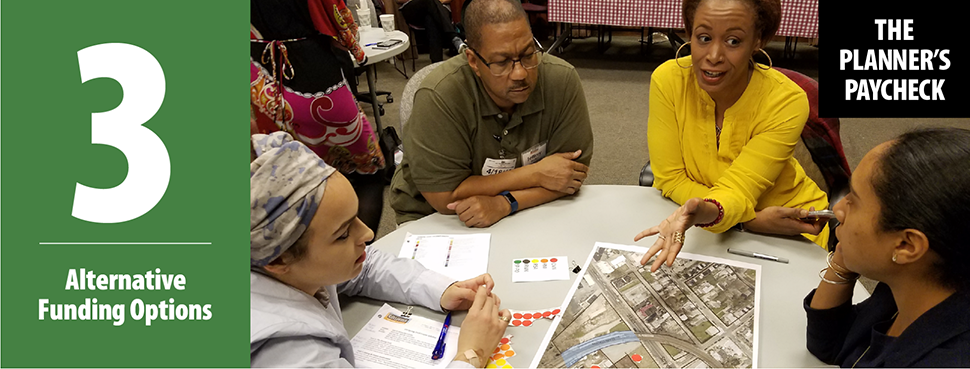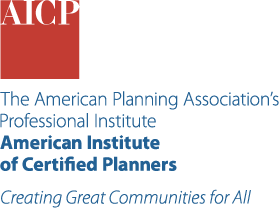The Planner's Paycheck: Where We Go from Here

There are good reasons why a planner may not know how their position is funded. Many planners work for large public agencies or private companies, which have hundreds or thousands of employees and potentially dozens of distinct revenue streams. By design, the work that planners do often supports multiple, interrelated objectives and is, therefore, less likely to be paid for by a single source of revenue than, say, a building inspector.
In times of political stability and economic optimism, there may be no urgent need to untangle this complex web or rethink how we pay for planning. But in our current moment, we may not be able to rely on our work speaking for itself. As explored in Part 1 of "The Planner's Paycheck," we are facing tremendous disruption and uncertainty that threatens the status quo in local government funding. But, as we examined in Part 2, this is certainly not the first shock to the profession. Now, in Part 3, it's time to put the pieces together and talk about where we go from here.
First, let's make sure we know the specific sources that fund our positions so that we can identify and assess the potential effects of federal policy shifts or an economic downturn. Then, we can start to explore some alternative ways to pay for planning. Finally, we can learn to tell the story of planning in ways that promote the profession and benefit the communities we serve.
Get a Handle on Your Position's Funding
There are a few simple steps planners can take to get a better handle on how their employer pays for their work.
1. Identify Sources of Revenue
If permissible, take a close look at the most detailed version of your employer's annual budget. At the highest level, you'll notice one or more sources of revenue and various broad expenditure buckets. But if you drill down deeper, you will likely see some revenue sources are dedicated to specific functions, programs, projects, or facilities, while others are general-purpose funds.
Next, see if you can identify all the sources of revenue that offset your position's costs, noting each dedicated revenue source that supports your department, division, or unit. If your team isn't fully funded by dedicated sources, note each revenue source that feeds into your employer's general fund.
Then, try to estimate what proportion of your work is attributable to dedicated sources versus general funds. And, for extra credit, document the share of general-purpose funds contributed by each distinct source.
If this information isn't clear from inspecting the documents available to you, try scheduling an informational meeting with your supervisor or someone else who has more in-depth knowledge of your organization's budget structure and constraints.
2 Quantify Your Dependency on Project-Based Funding
For planners whose positions are funded, at least in part, by dedicated sources, it's important to get a handle on the extent to which your position relies on funds tied to specific projects. Project-based funding is, by definition, time-limited and outcome-oriented, and any associated planning work must be closely connected to project deliverables.
Planning positions that are highly dependent on project-based funding are either explicitly temporary or tied to some version of a "business-development" process. In the public and nonprofit sectors, this process is often synonymous with grant writing, while in the private sector, it frequently entails cultivating business leads and responding to requests for proposals.
If your employment isn't explicitly tied to a specific project but is highly dependent on project funding, try to learn more about your employer's business-development process. At a minimum, this may give you a better sense of how vulnerable your position may be to sudden changes in external funding opportunities. And after learning more about your employer's process, you may have ideas about how to better establish or cultivate relationships with potential project funders or partners.
3. Consider How Planning Decisions Affect Revenue
In the public sector, planning is not primarily a means of generating revenue. However, it is important to remember that local planning decisions, in combination with fiscal structure, do affect local revenue levels. This is true in a straightforward way when plan-driven public investments lead to increased property values and, therefore, property tax revenue. But it's also true when planners and local officials use zoning or other regulatory tools to maximize the fiscal return on investment of private development projects.
Compact, mixed-use development typically provides much more in revenue to local jurisdictions than it costs to service. Conversely, low-density residential development is often a net drain on local resources. Furthermore, cities and towns in states with strict limits on property taxes have incentives to foster land use and development patterns that can boost other forms of revenue. For example, jurisdictions that rely heavily on sales taxes may apply extensive commercial zoning near their borders to offload some of the costs of service provision on neighboring jurisdictions. And those who depend on local income taxes may calibrate regulations and incentives to maximize job growth.
If you are working in local government, think about how your jurisdiction's plans and plan-implementation tools relate to fiscal structure. And consider whether your community may benefit from explicitly considering the fiscal impacts of its planning-related decisions. For planners in the private sector, it may still be helpful to get a better grip on how local planning decisions affect fiscal health and, by extension, demand for contracted planning services.
Explore Potential Revenue Alternatives
Every new revenue source has tradeoffs. So, in exploring new potential revenue sources, we should consider not only whether a source can be used but also how it relates to other community priorities. To illustrate, the Rethinking Revenue project, led by the Government Finance Officers Association (GFOA) in partnership with APA, identified six criteria for evaluating revenue options:
- Fairness to taxpayers and ratepayers
- Accountability
- Adequacy of revenue production
- Impacts on the behavior of taxpayers and ratepayers
- Cost of administration
- Promotion of positive intergovernmental dynamics
As with so many planning-related issues, context is crucial. A source that would work well for one employer may be ineffective (or unavailable) for another. But for the sake of discussion, here are four potential options that may be worthy of further exploration.
Could You Tap the Value of Existing Assets?
Many local jurisdictions own physical assets with commercial potential, like surplus property or public parking facilities, that could be tapped to pay for planning. According to GFOA's Rethinking Revenue Project, urban wealth funds could be the key to unlocking this potential.
An urban wealth fund (UWF) is a collection of public assets managed by a professional, independent entity to generate public revenue for capital investments and operations. With the right collection of assets and skillful management, this approach could generate far more revenue than land disposition or privatization agreements.
While the fund's charter would need to specify planning work as a permissible use of funds generated, there is a strong case to be made that UWFs should be tied to planning. Planners could play a pivotal role in identifying and analyzing opportunities for infill, redevelopment, and adaptive reuse of underutilized assets, as well as other planning initiatives that could help raise the market value of UWF assets.
UWFs have been successful in generating billions of dollars for local funding in Europe and East Asia, but so far, they are rare in the U.S. However, GFOA is working with local jurisdictions to help them evaluate the value of their assets and explore opportunities for establishing UWFs. And Atlanta and Tulsa, Oklahoma, have already taken crucial steps toward implementing new UWFs.
Can You Make a Case for Land Value Taxation?
Split-rate property taxation is a land value taxation system that imposes different tax rates on land and improvements (e.g., buildings). Most importantly, it imposes a higher rate on land than on improvements. This approach recognizes that the value of land depends primarily on collective decisions, rather than on the investments of individual property owners. Furthermore, it discourages land speculation and underinvestment.
The connection to planning is relatively straightforward. Planning is the mechanism by which we make collective decisions about land use and development patterns as well as public investments that confer value on individual parcels of land. So, why not reform our property tax system to more fairly capture the public benefits of planning while also incentivizing property owners to build more housing and other valuable improvements that both address local market demands and generate additional local economic activity?
Of course, part of the reason why many communities struggle to pay for planning now is tied to state-imposed limits on property taxes. Furthermore, local property owners seldom embrace changes to property tax systems, even if the changes don't impose a net increase on most owners. So, the political headwinds for this approach are strong, especially outside of states like Pennsylvania, Hawaii, and Connecticut, which have explicitly authorized split-rate taxation systems for certain jurisdictions. If you aren't in one of those states, this may be an area of opportunity for future advocacy work in partnership with other local government professionals.
Should You Update Franchise Fees?
Franchise fees are the rent that private utility companies pay to local governments to use their rights-of-way. Many cities, towns, and counties already use franchise fees, but the rates they charge may not be keeping up with the fair market value of their land. Comparing current rates to the rates private landowners are charging for easements is probably the most straightforward way to identify whether your local jurisdiction is charging too little rent.
While franchise fees are already a common supplemental source of local revenue, there is a strong case to be made that a higher percentage of this revenue should go to paying for planning work. Planners help communities formulate plans that establish local street networks and the allocation of right-of-way space to different users. Furthermore, they facilitate the implementation of those plans by reviewing private land development applications.
Most states have explicitly authorized local governments to negotiate franchise fees with utilities and dictate how that revenue must be spent. Even in states where franchise fees must be used for right-of-way investments, local officials would be justified in allocating a portion of that revenue for planning work. Local jurisdictions could use a cost-allocation study to document the proportion of time spent by planning staff on right-of-way-related activities.
Is It Time for Regional Sharing?
For some cities, towns, and counties, there may be opportunities to maximize the efficacy of limited funding for planning through shared service agreements. In practice, this could mean creating a joint planning agency, contracting with a neighboring jurisdiction to rent time from a staff planner, or pooling resources to hire a planner that serves multiple jurisdictions.
While this isn't a revenue generation strategy, it can preserve planning capacity and improve regional coordination. Consider a scenario where local officials in two small neighboring towns can each only commit to funding a half-time staff planner. Separate recruitment processes for two part-time planning positions would likely be more difficult and less efficient than partnering to hire a single full-time planner. And it would certainly be preferable to have both towns opt to forgo planning staff altogether.
Extreme fiscal disparities across metropolitan areas pose a related limit on paying for planning. Many commentators have noted that the fragmented nature of local government and associated interlocal competition act as barriers to effective regional planning. In practice, neighboring jurisdictions in the same metropolitan area can have very different property markets and tax bases. In these cases, regional tax-base sharing may offer a significant improvement over the status quo.
Perhaps the most prominent success story is in the Minneapolis-St. Paul metro area in Minnesota, which has been sharing nonresidential property tax revenue for more than 50 years. While there are no legal barriers to local jurisdictions agreeing to share revenue, in practice, this is another approach that would likely require state action.
Hone and Tell Your Planning Story
Collectively, planners need to get a better handle on identifying the tangible benefits of planning and sharing those benefits in ways that resonate with federal, state, and local leaders. It's very hard to make a case for retaining or strengthening planning capacity if you can't tie money spent on planning to specific beneficial outcomes.
Document the Value of Planning
We know planning has tremendous potential to confer broad social, environmental, and economic benefits. Furthermore, through its Voice of Planning initiative and It Takes a Planner campaign, APA has learned more about the specific messages and framing that resonate with local elected officials. APA has even created a simple one-pager that distills the essence of why it makes sense to invest in planning.
However, there is still much work to do to establish the measurable benefits of our labor. Many researchers have explored the multidimensional relationship between planning and economic development. But, so far, most local efforts to measure the performance of planning departments have focused narrowly on process metrics, such as the total number of permits issued or the average time from application to decision. While these metrics may be important, they don't tell a very clear story about why we devote resources to planning.
Craft Powerful Narratives
While local elected officials appreciate the role planners play in helping them make data-informed decisions, this doesn't mean that data speaks for itself. To be effective advocates for the value of planning, we must become good storytellers.
To be effective, we need to center the themes that resonate the most with the communities we serve, and we need to craft narratives that feature relatable characters navigating familiar situations. Finally, while familiarity with technical concepts may be necessary for formulating plan recommendations or policy instruments, we must learn to translate these concepts into plain language.
Conclusions
In the U.S., most planning is local, and planning capacity is largely dependent on the fiscal health of local governments. While planners may have no direct ability to affect federal funding levels or trade or immigration policy, we can be better prepared to respond to external shocks. For some of us, this will mean getting more familiar with not only the revenue sources that we've traditionally used to pay for planning but also with alternative funding strategies that may help the profession adapt.
As we begin to chart a new course, we can examine how previous shocks shaped the profession. And we can work together to develop new ways to document and share the value of the work we do. While this is the end of this series, it's certainly not the end of the discussion. I'm looking forward to continuing to work on the related challenges of strengthening the profession, improving our understanding of effective planning practices, and telling our story in new and compelling ways.
Top image: Courtesy Philadelphia Citizens Planning Institute


